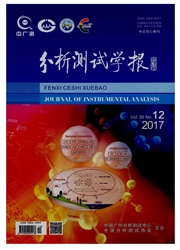

 中文摘要:
中文摘要:
近年来,纳米材料在电化学生物传感器领域的研究已成为前沿性的内容。纳米材料具备优异的物理、化学、电催化等性能,加之其量子尺寸效应和表面效应,可将传感器的性能提高到一个新的水平。基于纳米材料的电化学生物传感器呈现出体积更小、速度更快、检测灵敏度更高和可靠性更好等优异性能。该文按照纳米结构的分类,综述了近几年基于以下纳米材料在电化学生物传感器领域的最新发展和应用:零维纳米材料——纳米微粒;一维纳米材料——纳米管、纳米线和纳米棒;二维纳米材料——纳米超薄膜。引用参考文献78篇。
 英文摘要:
英文摘要:
In recent years, it is of great theoretical and practical value to make a research on electrochemical biosensors. People are paying more and more attention to the preparation of biosensors based on nanomaterials, and the nano-technology has provided infinite imagination space for the development of electrochemical biosensors. Nanomaterials not only have the excellent physical, chemical and electrocatalytic properties, but also show the quantum size effect and surface effect, which can improve the electrochemical biosensors obviously to a new and high level. Therefore, the electro chemical biosensors based on nanomateirals show many excellent performances, such as smaller volume, faster speed, higher sensitivity and better stability, etc. According to their structures, the nanomaterials can be divided into three categories, e.g. zero-dimentional, one-dimensional and two-dimensional nanomaterials. In this article, the development and application of electrochemical biosensors based on following nanomaterials, zero-dimensional nanoparticles (such as metal nanoparticles, quantum dots, magnetic nanoparticles, etc. ), one-dimensional nanomaterials (nanotubes, nanowires and nanorodes) and two-dimensional nanostructured thin films (like graphene) were reviewed. 78 related references were cited in this review.
 同期刊论文项目
同期刊论文项目
 同项目期刊论文
同项目期刊论文
 Multiwall carbon nanotubes-poly(diallyldimethylammonium chloride)-graphene hybrid composite film for
Multiwall carbon nanotubes-poly(diallyldimethylammonium chloride)-graphene hybrid composite film for Facile preparation of a Pt/Prussian blue/graphene composite and its application as an enhanced catal
Facile preparation of a Pt/Prussian blue/graphene composite and its application as an enhanced catal Recognition and Electrochemical Determination of Environmental Contaminants Nitrophenol by Cyclodext
Recognition and Electrochemical Determination of Environmental Contaminants Nitrophenol by Cyclodext An ionic liquid-modified graphene based molecular imprinting electrochemical sensor for sensitive de
An ionic liquid-modified graphene based molecular imprinting electrochemical sensor for sensitive de A Novel Method for Bisphenol A Analysis in Dairy Products Using Graphene as an Adsorbent for Solid P
A Novel Method for Bisphenol A Analysis in Dairy Products Using Graphene as an Adsorbent for Solid P The fabrication of poly (acridine orange)/graphene modified electrode with electrolysis micelle disr
The fabrication of poly (acridine orange)/graphene modified electrode with electrolysis micelle disr Determination of benzoic acid in milk by solid-phase extraction and ion chromatography with conducti
Determination of benzoic acid in milk by solid-phase extraction and ion chromatography with conducti Graphene-based solid-phase extraction disk for fast separation and preconcentration of trace polycyc
Graphene-based solid-phase extraction disk for fast separation and preconcentration of trace polycyc Fabrication and characterization of a triple functionalization of graphene oxide with Fe3O4, folic a
Fabrication and characterization of a triple functionalization of graphene oxide with Fe3O4, folic a Synthesis and characterization of glycyrrhizin-decorated graphene oxide for hepatocyte-targeted deli
Synthesis and characterization of glycyrrhizin-decorated graphene oxide for hepatocyte-targeted deli A Selective Voltammetric Method for Detecting Dopamine at Quercetin Modified Electrode Incorporating
A Selective Voltammetric Method for Detecting Dopamine at Quercetin Modified Electrode Incorporating Correlations of six related pyrimidine metabolites and diabetic retinopathy in Chinese type 2 diabet
Correlations of six related pyrimidine metabolites and diabetic retinopathy in Chinese type 2 diabet Determination of Glycolate Acid, Mono- and Dichloroacetic Acids in Synthetical Betaine by Anion-exch
Determination of Glycolate Acid, Mono- and Dichloroacetic Acids in Synthetical Betaine by Anion-exch Stereoselectivities in alpha- and beta-Amino Acids Catalyzed Mannich Reactions Involving Cyclohexano
Stereoselectivities in alpha- and beta-Amino Acids Catalyzed Mannich Reactions Involving Cyclohexano 期刊信息
期刊信息
